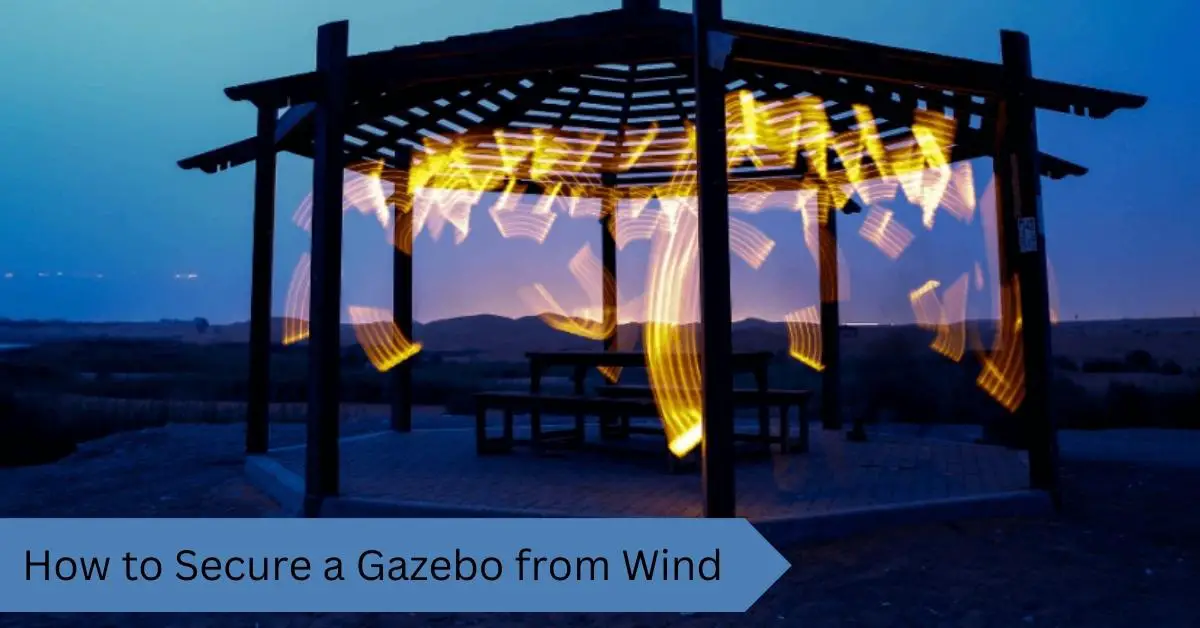Securing a gazebo from wind damage is crucial to ensure the safety of those using it and to prevent costly repairs or replacements. Wind can cause severe damage to an unsecured gazebo, including collapse, displacement, or even destruction.
A gazebo can withstand strong winds and remain stable and secure by implementing the proper securing methods, such as anchor points, guy wires, or braces. It is essential to assess the risk of wind damage in the area where the pavilion is located and choose the appropriate securing methods accordingly.
Regular maintenance and inspections of the securing systems are also necessary to ensure they remain effective over time. Owners can enjoy their outdoor living spaces with peace of mind by taking the necessary steps to secure a gazebo from wind damage, even during inclement weather.
How to Secure a Gazebo from Wind: Gazebos can be secured using leg weights, rope and pegs, anchoring kits, polypropylene straps, and threaded rods. These methods are designed to provide stability and prevent wind damage to the pavilion.
This blog post will discuss tips for securing a gazebo from the wind. We will also provide information on installing a wind kit for added protection. Let’s get started!
How can winds damage a gazebo?
Many people enjoy spending time outdoors in their pavilions, but high winds can seriously threaten these structures. Without the proper precautions, wind can easily tear the roof off a gazebo or even lift the entire structure off the ground.
There are a few different ways to secure a gazebo against high winds. One option is to use an anchor kit to secure the gazebo to the ground. Another option is to utilize ropes or straps to tie the gazebo down.
Finally, weights can also help keep a gazebo in place. These precautions can help ensure your gazebo stays safe in high winds.
How do you ensure a gazebo’s security during strong winds??
The gazebo is a very vulnerable structure that can be easily knocked over by the wind. It’s essential to use methods like leg weights, ropes, and anchoring kits to secure it from high winds, so you don’t need repairs or additional parts after an event has passed.
The strategy you employ to keep your gazebo in place depends mainly on the ground type.
Today we’ll discuss how to keep your gazebo in place during windy weather when it is placed on grass and concrete.
Before going to secure your gazebo check these things:
- Gazebo Type
- Surface
Gazebo Types:
Here are some common types of gazebos:
1. Pop-up Gazebos
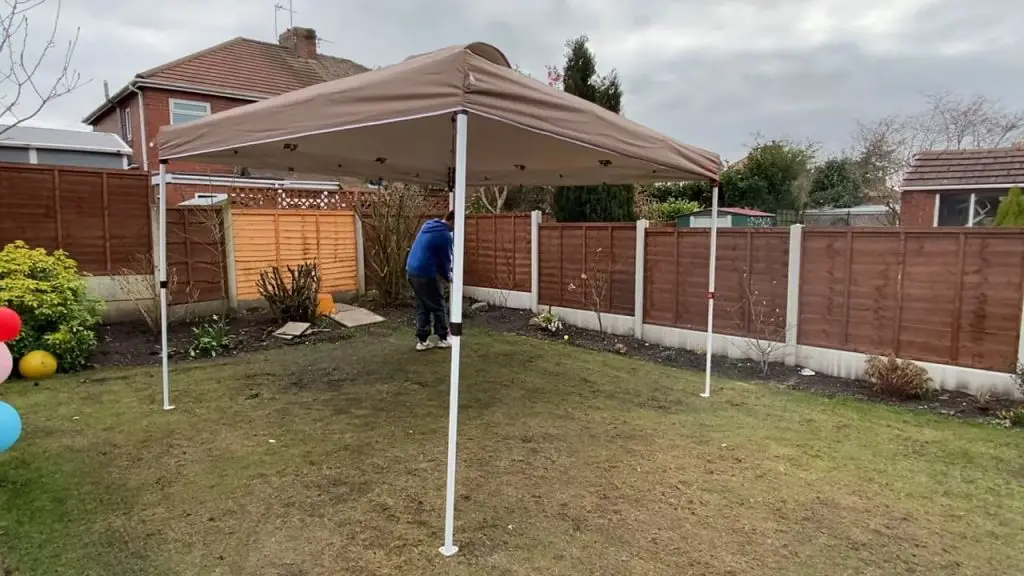
Gazebos are a fun way to enhance your backyard without spending much money. Various styles, materials, sizes, and prices fit any budget. When deciding what to buy, think about what you want to do with it.
To be functional, a pop-up model must be fully assembled before use. This style is the most cost-effective and often comes with a built-in shade that helps shield you from the sun during the hot summer months.
Pop-up models are great for entertaining guests and may be the perfect solution for you if you want to use it for the occasional party.
2. Assembled Gazebos

Gazebos that are already assembled are another option to consider. Assembled gazebos are usually more expensive and take a lot of time to assemble.
They are often easier to transport and can be used in any weather.
However, if you’re unsure what to do with it, you may want to opt for a preassembled model.
3. Permanent Gazebos
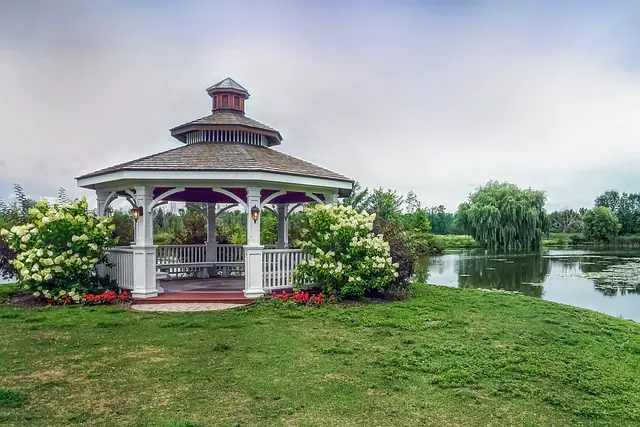
If you need a gazebo for the long term, you should opt for a permanent structure. These types of models don’t need assembly or disassembly and are usually made of steel or aluminum frames. You can add awnings, benches, tables, and seating areas to increase the versatility of this type.
If you plan on keeping the gazebo around for a while, you might want to look at a permanent model, as you may find that it’s more durable and holds up better over time.
Different Surfaces
When deciding which type of gazebo to buy, you must first consider the surface on which it will be erected. The different characters have their own unique protection methods and can cause problems when tried outdoors with strong winds in some cases.
1: Concrete
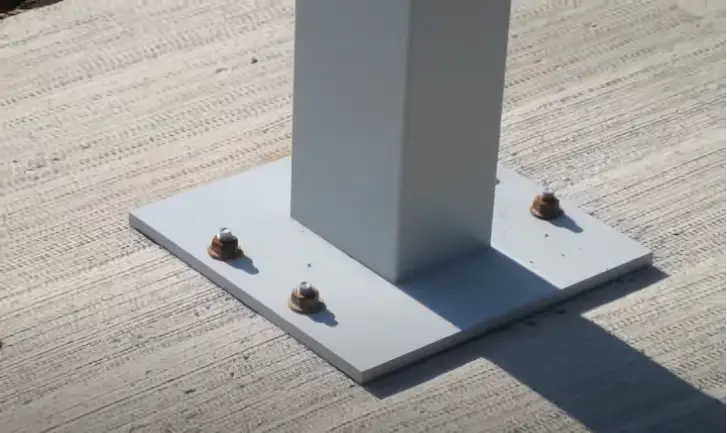
If you’re looking for the perfect spot to pitch your tent, Concrete is an excellent choice. It’s flat, and even so, there won’t be any pesky rocks or trees poking up where they don’t belong.
The most common methods of fixing it are with concrete legs for gazebos as well polypropylene straps which can also hold heavy loads if need be – this way, nothing holds us back from enjoying our time outside anymore!!
2: Grass
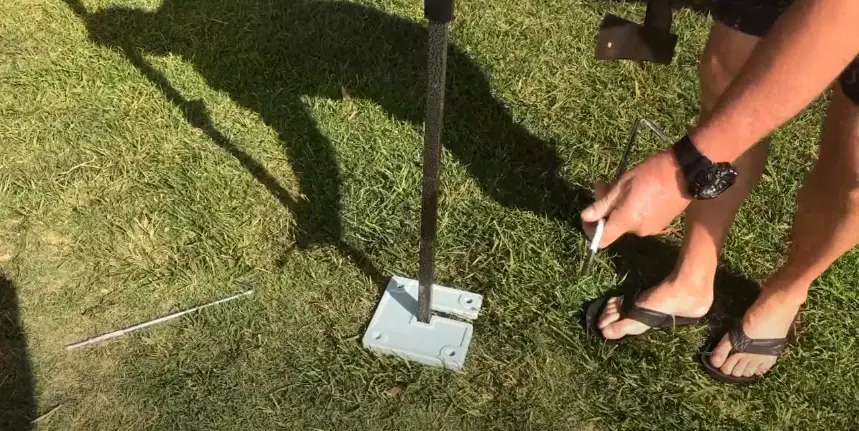
The grassy surface of your gazebo offers more protection than concrete; though it might not be as smooth and even, wind can’t quickly shake or roll up on this type of environment. You can also use rope and pegs rods, threaded rods or anchoring kits for securing your gazebo onto cement surfaces.
Artificial Grass
An artificial lawn is a more modern option, but it still offers many benefits. For one, it’s an excellent option for small spaces, since it’s less bulky than grass. It’s also easy to clean, and you don’t have to worry about growing weeds or grass, as it’s all done for you.
However, if you want a lush lawn, you’ll want to invest in a natural grass surface. For wind security, proper setup is essential, and it is the primary key to stable a gazebo in the wind:
Gazebo Setup

If you’re building a gazebo, you need to know how to secure it from wind.
If you do not, you could end up with a gazebo that is not sturdy enough to withstand the elements.
The following tips should help you set up your gazebo properly.
Make Sure Your Gazebo Is Level
It may seem like an easy thing to do, but a lot of people don’t realize that your gazebo should be level. If your gazebo is not level, the wind will cause it to tip, especially during a storm.
This can lead to some serious issues, such as the gazebo toppling over and damaging your property, or possibly even injuring someone who happens to be standing underneath it.
Make Sure Your Gazebo Has Proper Protection
To protect your gazebo, you need to make sure that there are no gaps in the structure. If you leave any gaps, the wind will blow through it and cause the gazebo to tip over.
For this reason, you want to cover up the bottom, sides, and roof of the gazebo to ensure that the wind can’t get through.
Use Strong and Sturdy Posts
When choosing posts, make sure that they are strong and sturdy. For example, you want to avoid using too weak posts, such as thin bamboo poles. This is because the wind will cause these poles to bend or break.
Use a Post with a Round Base
If you’re looking for posts with a round base, it’s best to go with wood. This is because wooden posts will last much longer than those with a flat base.
The same goes for steel if you’re looking for something more substantial. If you use a wooden post, you’ll want to use a square post to keep the gazebo level.
Use Square or Round Posts
Your posts will vary depending on whether you want to keep your gazebo level. This is because if you want a level pavilion, you’ll want to use a square post. If you don’t want your gazebo to be level, then you’ll want to use a round post.
Use a Post with a Tight Grip
When you install your posts, you want to ensure they are tight. This is because you don’t want the gazebo to move. You can do this by tightening the screws used to secure the posts together.
Use Locking Plugs
Another thing that you can do to help ensure that your posts don’t move is to use locking plugs. The reason for this is that these plugs prevent the screws from moving.
Use a Screw With a Round Head
The screws you use will also depend on whether you want to keep your gazebo level. If you want to keep your gazebo level, then you’ll want to use a screw with a round head.
This is because you’ll want to use a screw with a round head if you want your gazebo to stay level.
What are the benefits of securing your gazebo from the wind?
Securing a gazebo from the wind can provide several benefits, including:
Safety: Securing a pavilion from the wind can help prevent it from collapsing or causing injury to people using it.
Durability: Wind can cause damage to a gazebo’s structure, including warping or breaking of wood and bending or loosening of metal parts. By securing the pavilion, its durability can be improved, and costly repairs or replacements can be avoided.
Longevity: A gazebo adequately secured from the wind is more likely to last longer, and its aesthetic appeal can be maintained for an extended period.
Peace of Mind: When a gazebo is securely anchored, it provides peace of mind to those using it, especially during inclement weather.
Protection from damage
High winds can cause a lot of damage to your gazebo. Wind gusts can knock over furniture, rip off roofing materials, and even collapse the entire structure. By securing your gazebo, you can protect it from damage and prolong its lifespan.
Increased safety
An unsecured gazebo can be dangerous in windy conditions. Loose furniture and other objects can become projectiles and cause injury to people or property damage. Securing your gazebo can reduce the risk of accidents and keep your family and guests safe.
Improved stability
A pavilion that is not adequately secured can sway in the wind and feel unstable. This can make it difficult to relax and enjoy the space. By securing your gazebo, you can improve its stability and make it a more comfortable place to spend time.
Longer lifespan
A gazebo exposed to the elements and subjected to high winds is more likely to deteriorate quickly. Securing your gazebo can extend its lifespan and save money in the long run.
More useable space
You can use your gazebo more often when it is secured from the wind. Even on windy days, you can enjoy the protection and comfort of your gazebo. This can increase the value of your outdoor space and make it a more enjoyable place to be.
Overall, securing a gazebo from the wind is a crucial step in ensuring its safety, longevity, and durability, and it can provide peace of mind to its users.
How to Secure a Gazebo from Wind?
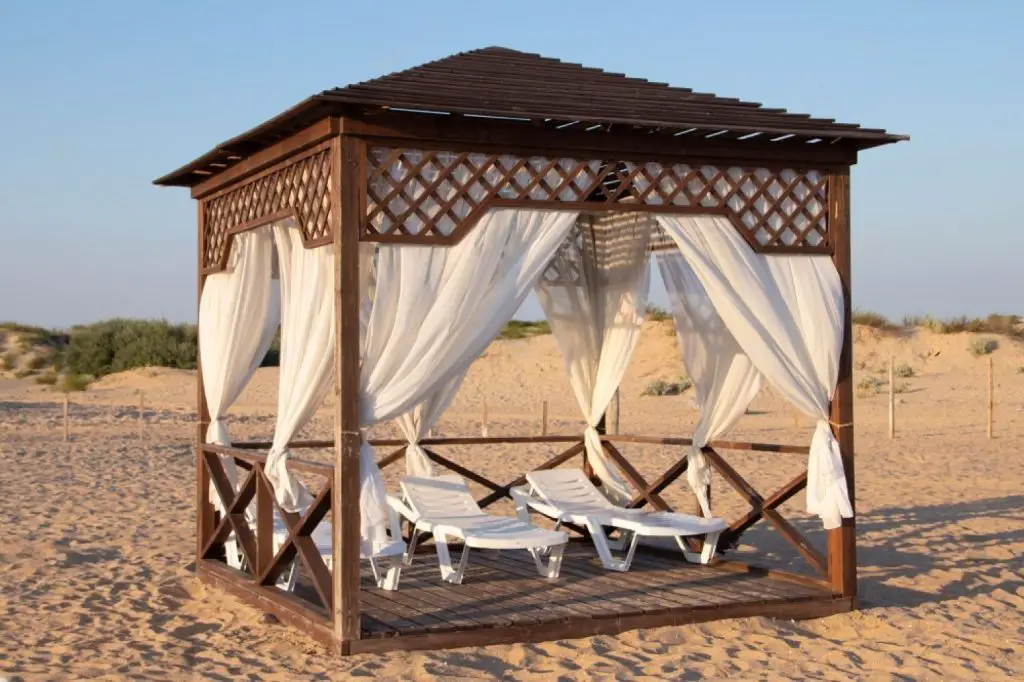
To secure your gazebo, there are several things you can try. Before choosing a technique, make sure to check the following, some of these we have explained above:
- Gazebo Type (assembled, pop-up, permanent)
- The type of surface (e.g. grass, tiles, concrete) can impact the gameplay.
- Nearby structures (trees, houses, fences, etc.)
The height of your gazebo is an essential factor when securing it. You’ll want to make sure that you confirm the corners and edges with stakes, ropes or wire so they don’t blow away in high winds like some other people’s tents might.
Securing your gazebo is easy with the right tools. Here are some permanent methods that will keep it strong and upright while also ensuring you can move around comfortably during bad weather or when guests visit.
1. Tent pegs and rope
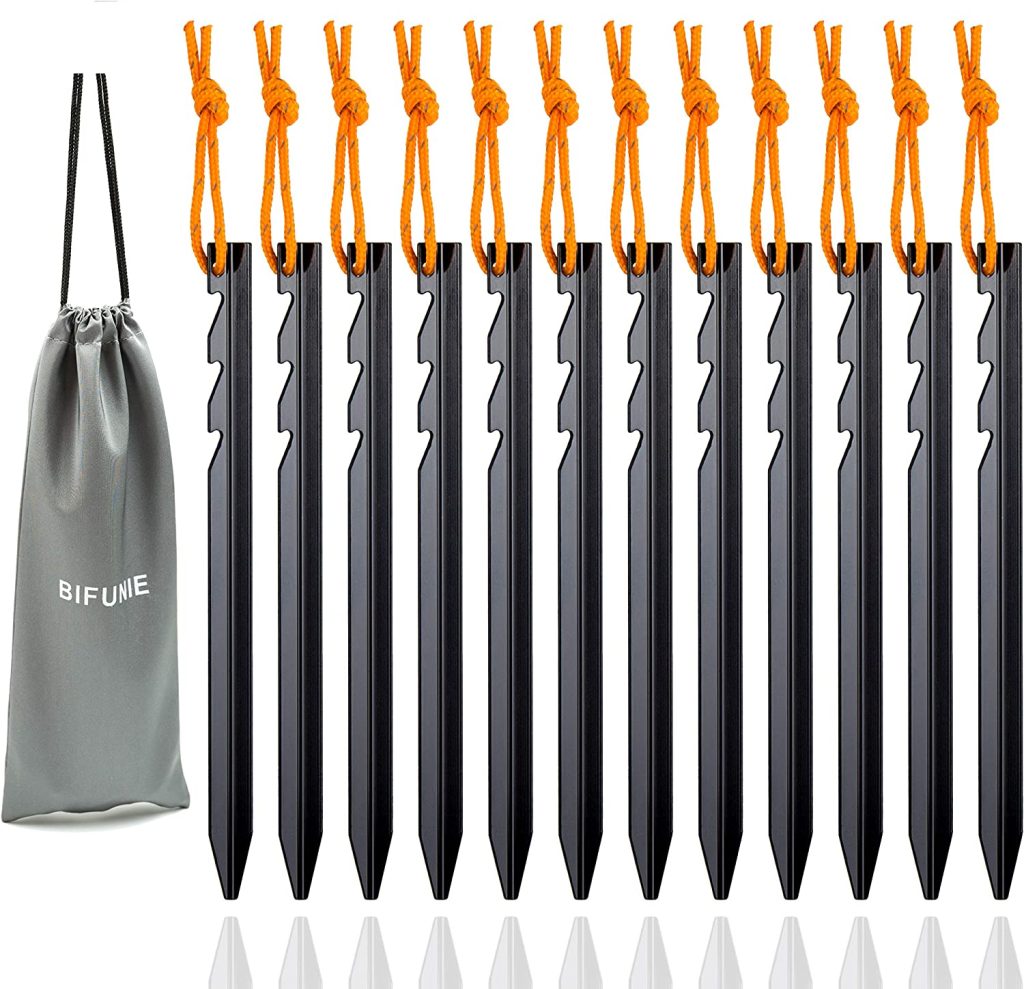
The easiest way to keep your gazebo in one piece is by using tent pegs and rope. This is by far the simplest and most inexpensive way to secure a gazebo.
Most of them have strings attached, so you must secure them properly. You can add some extra webbing or cord onto the frame if necessary for stability.
To ensure your gazebo is stable, you should stake it out first by tying ropes around nearby structures. This way, if there’s any wind at all – which would be rare in this area because of how still everything usually lays – they’ll stay put without sweeps across their surface getting blown away.
Once you have your tent pegs secure, it’s time to install them in the ground. Most gazebos come with holes for this function, so there is no need to worry about finding one.
To ensure that your gazebo remains tethered and doesn’t get blown away in strong winds, you’ll need to bring it down temporarily.
2. Storm straps
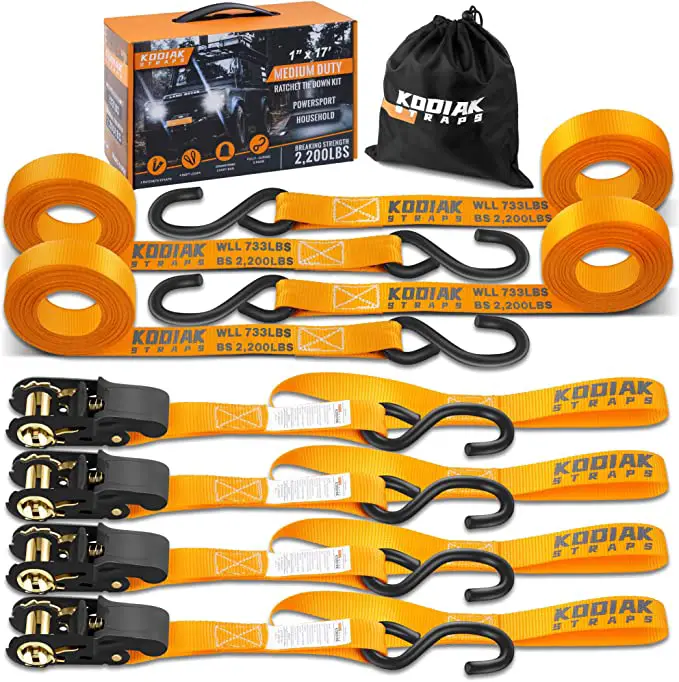
Another best way to keep your gazebo safe during a storm is by using storm straps. These polypropylene ropes will secure the whole structure, no matter how strong of gusts are present.
Unfortunately, The idea behind this is that you’ll need to put some pegs or straps on the ground, secure them with rings from there and then attach them yourself.
If not doing so would be too uncomfortable for whatever reason (older people), they can also use these fixtures instead.
You should remember that gale-force winds still have a good chance of damaging your beautiful new gazebo, so it is best to take it down if you expect any storms.
3. Weights
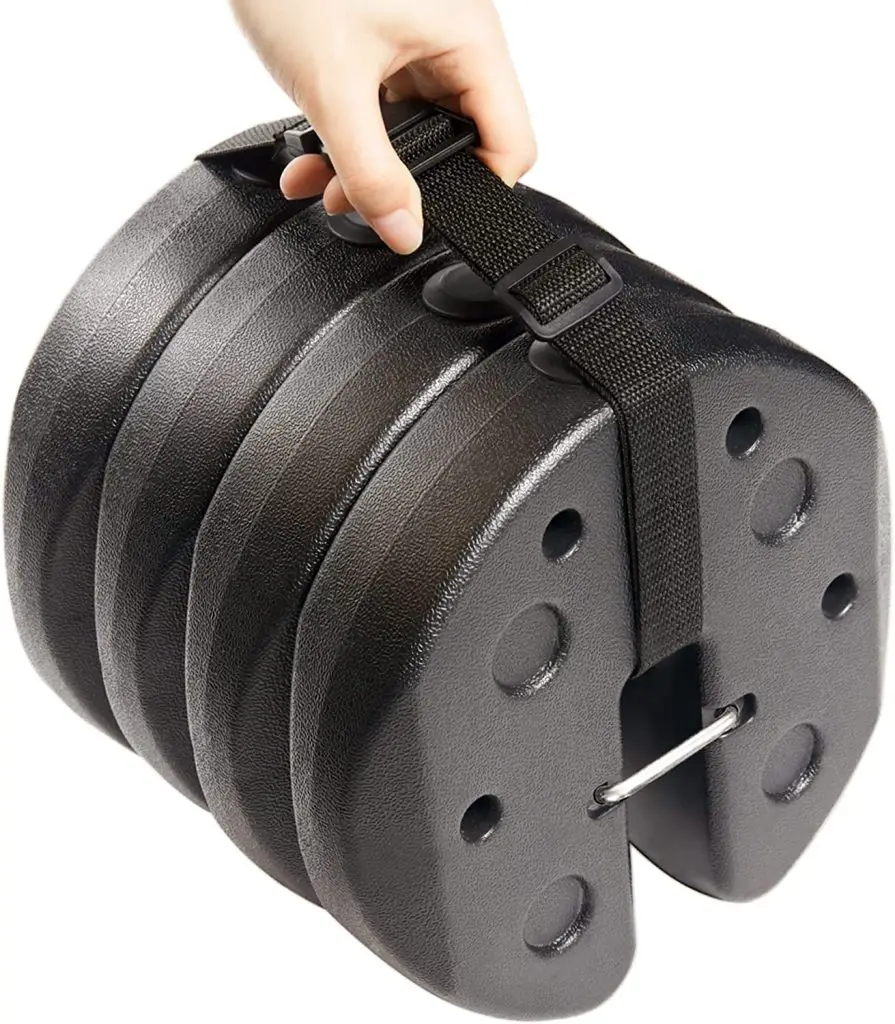
By using weights, you can secure your gazebo without having to do any invasive maneuvering. You will either need a mainly designed weight for the legs of a given type or make it yourself.
When you finish your project, secure some bags to the gazebo legs. Make sure each bag weighs around 12-24 kg or more if needed for stability so that it won’t tip over in high winds as this one did.
Depending on how strong and fast the wind is, you may have 60 to 100 kilos (132 pounds).
This weight will be distributed equally between all four legs of your gazebo so that it doesn’t blow away or collapse under its own force.
4. Threaded rods
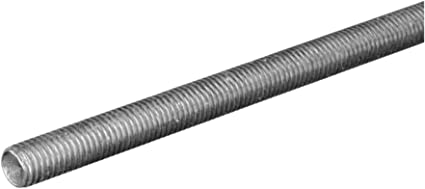
You can make your gazebo more permanent by installing threaded rods. These are usually 61 cm (24 inches) long, and two per foot will suffice for a very secure installation on concrete surfaces, but it’s best if you measure the length before purchasing since some Depths come shorter than others.
You can purchase pre-made gazebos that are ready to be installed. If you don’t have any holes in your foot piece or if they’re not available, then this will require some work on your behalf of yourself and an appropriately sized drill bit for making the appropriate size puncture wounds into both wood surfaces so as not to damage either one.
5. Bolts
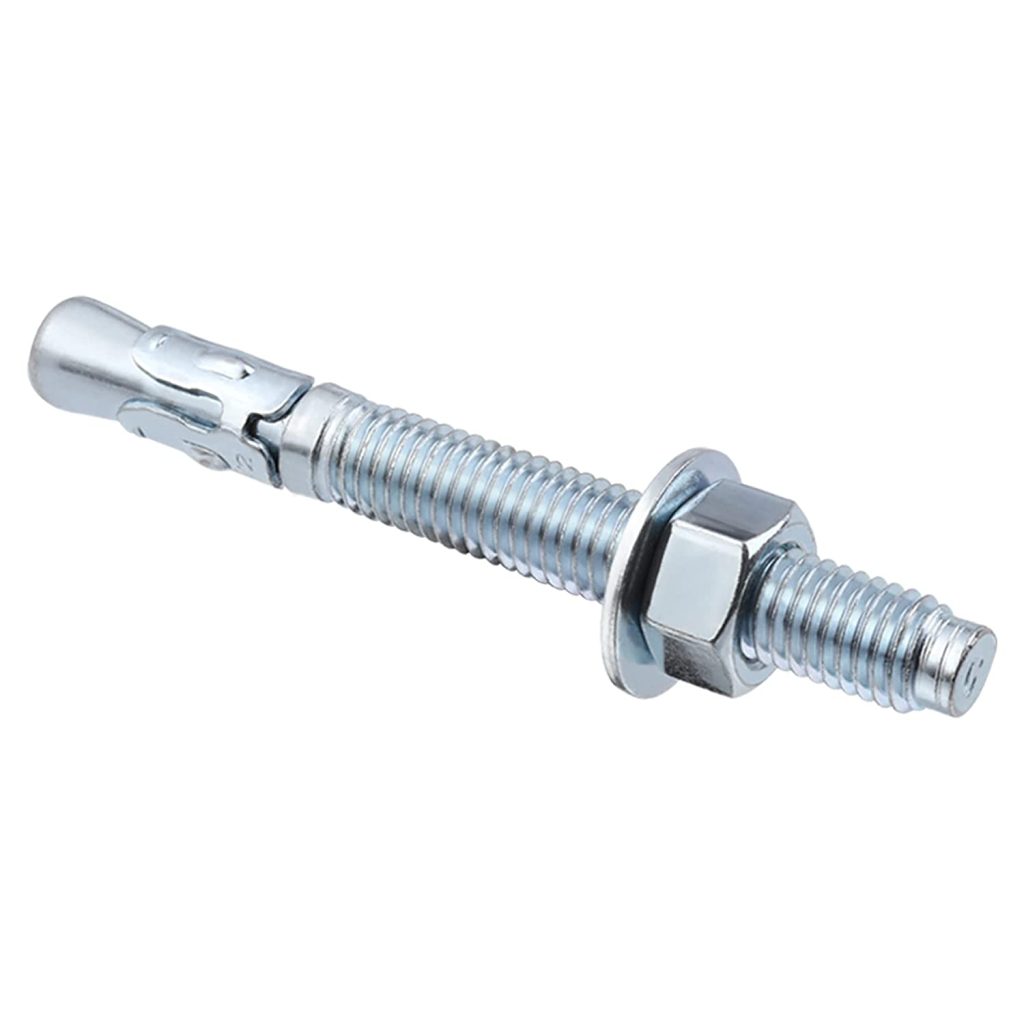
The bolts are another way to secure your gazebo, especially if you have a concrete patio. You will need to drill some holes for them to fit correctly, so again, this option may not work well with certain flooring materials or surfaces that could get damaged easily by drills.
Two bolts per foot are the best way to anchor your gazebo. But if you won’t be leaving it up for long periods, then this method isn’t the perfect choice and should only serve as a short-term solution until something more permanent can happen.
6. Gazebo walls

Installing some walls is an excellent way to strengthen your gazebo and prevent it from acting like a parachute. The wind will be redirected, which means the more substantial material of these barriers should help keep you safe inside.
When building a gazebo, it’s essential to consider how well they work with other methods.
The feet will still need securing, and you may have trouble taking them down if the wind gets too firm, so keep this in mind when deciding whether or not your project should include one.
Attach the gazebo to another gazebo.
This method of securing a gazebo is to attach the gazebo to another gazebo using threaded rods. This is the most stable method of securing a gazebo, as it is the strongest way to secure a gazebo.
Extra weight from the adjacent gazebos helps prevent wind from picking up the sides of the gazebo by connecting its legs with a bungee rope. In addition, it works on any surface, so it’s perfect for pavilions on either side.
Anchoring kits

It’s a good idea to anchor your gazebo because it can be damaged in high winds. Anchoring kits are similar to pegs and ropes but are more secure as the pegs are corkscrewed, which makes it harder to get out of the ground.
The pavilion should be securely fastened to the ground by screwing 4 pegs into each corner and then pulling the straps through the loops of the pegs to the inner roof bars.
Drill the Gazebo into Concrete
If you plan to use a gazebo for many years, you must drill holes into the concrete that can hold the gazebo securely in place. While this is usually done for aesthetic purposes, it’s important to remember that your gazebo may be the sole protection for your investment in the future. Here’s how to drill into concrete.
Prepare the area
If your gazebo is located outside, first make sure that you’ve cleared the area of any loose material. Once you’ve removed any debris, dig around the area to ensure no exposed utilities, such as pipes or electrical wires.
If there are, cover them up before you begin the process.
Drill the holes
Drill a hole at least 1/4 inch into the concrete. This should be drilled at an angle to go from vertical to horizontal. If you’re using an electric screwdriver, make sure that you insert the driver into the hole and turn on the power.
You may also need to apply a small amount of sand or a wood filler to the holes to avoid the screws from becoming loose.
Use the screws
Once you’ve finished drilling, place the gazebo on top of the concrete and then use the screws to secure the pavilion to the concrete. Place the screws in the same order you used to drill the holes.
Additional tips for securing your gazebo from wind?
Here are some additional tips for securing your gazebo from the wind:
If you’re looking to secure your gazebo from the wind, you can use various methods to help protect it from damage and extend its lifespan. Here are some additional tips for securing your gazebo:
Use guy ropes
Guy ropes can be used to provide additional support to your gazebo. These ropes can be anchored to the ground and attached to the corners of your gazebo. By tightening the ropes, you can help to stabilize your gazebo and reduce its movement in the wind.
Choose the right location.
Choosing the right location for your gazebo can make a big difference in its ability to withstand the wind. Look for a location sheltered from strong winds, such as a corner of your yard or a spot surrounded by trees or bushes.
Trim nearby trees
If you have trees or bushes near your gazebo, it’s a good idea to trim them regularly. Overhanging branches can rub against your gazebo in the wind and cause damage.
Choose the suitable materials.
The materials you use to build your gazebo can greatly impact its ability to withstand the wind. Choose materials that are strong and durable, such as cedar or redwood. Avoid using lightweight materials that the wind can easily damage.
Install a wind sensor:
Installing a wind sensor on your gazebo can help you to monitor wind conditions and take precautions when necessary. If the wind reaches a certain speed, the sensor can trigger an alarm that alerts you to the potential danger.
Add extra supports
Adding extra support to your gazebo can help improve its wind stability. This can be achieved by adding additional posts or braces to the structure.
Use sandbags
Sandbags can provide additional weight to the base of your gazebo. These can be placed around the pavilion’s perimeter or strategically to help keep it in place during windy conditions.
Install a wind-resistant roof.
A wind-resistant roof can help to protect your gazebo from damage. This can be achieved using a solid top or a roofing material designed to withstand high winds.
Check regularly for damage.
It’s essential to regularly check your gazebo for damage, especially after a windy day. Look for any signs of damage, such as cracks, loose screws, or bent poles. Repairing any damage promptly can help to prevent further damage and extend the lifespan of your gazebo.
Take down during extreme weather.
Taking down your gazebo completely in extreme weather conditions, such as hurricanes or tornadoes, is a good idea. This can help to prevent it from becoming a projectile in the wind and causing damage to other structures or property.
Protecting your gazebo from the wind is essential in protecting your investment and enjoying your outdoor space. Using these tips and taking the necessary precautions, you can help ensure your gazebo stays in good condition for years.
Maintenance and Upkeep
Regular maintenance and upkeep are crucial for ensuring that a gazebo remains secure over time. Without proper care, a gazebo’s structural integrity can weaken, making it more vulnerable to damage from wind and other elements.
Regular inspections and repairs can help identify and address issues before they become significant problems, saving time, effort, and money in the long run.
There are several tips and guidelines to maintain the various methods of securing a gazebo. For instance, checking anchor points regularly for wear and tear is essential to ensure they are still securely fastened to the ground.
Tightening bolts and screws as needed can also help keep the structure stable and secure. Additionally, replacing damaged parts promptly can help prevent further damage from occurring.
Regular maintenance tasks such as tightening bolts, lubricating moving parts, and cleaning debris from the structure can ensure a gazebo remains secure over time.
Keeping a maintenance log can help track when maintenance tasks were last performed and when the next ones are due. By making maintenance and upkeep a regular part of gazebo ownership, owners can enjoy their outdoor living spaces for years to come without worry.
Related article: HOW TO SECURE A GAZEBO FROM THE WIND
FAQ for securing gazebos
Can a gazebo withstand wind?
How do you anchor a gazebo without drilling?
How do you weight down a gazebo?
Another option is to tie the gazebo down with rope or bungee cords. Whichever method you choose, make sure the weights are evenly distributed around the gazebo.
What wind is too strong for the gazebo?
Is it better to leave the sides on a gazebo in the wind?
Conclusion
In conclusion, securing a gazebo from wind damage is crucial for ensuring its safety, durability, and longevity. Various methods to secure a gazebo include anchor kits, guy wires, leg weights, and polypropylene straps. Regular maintenance and upkeep of these securing systems are also essential to ensure their effectiveness over time.
By implementing the proper securing methods and following additional tips, such as choosing a sheltered location, using multiple securing methods, and regularly inspecting the gazebo’s securing systems, owners can enjoy their outdoor living spaces with peace of mind, even during periods of high winds or inclement weather. With these measures in place, a gazebo can provide a safe and enjoyable outdoor space for years to come.
We hope you will be well aware of How to Secure a Gazebo from Wind after reading this comprehensive article. If you have any questions, feel free to comment below!

